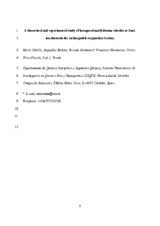Mostrar el registro sencillo del ítem
A theoretical and experimental study of hexagonal molybdenum trioxide as dual-ion electrode for rechargeable magnesium battery
| dc.contributor.author | Cabello Bermúdez, Marta | |
| dc.contributor.author | Medina, Alejandro | |
| dc.contributor.author | Alcántara, Ricardo | |
| dc.contributor.author | Nacimiento-Cobos, Francisco José | |
| dc.contributor.author | Pérez-Vicente, C. | |
| dc.contributor.author | Tirado Coello, José Luis | |
| dc.date.accessioned | 2024-01-11T07:41:43Z | |
| dc.date.available | 2024-01-11T07:41:43Z | |
| dc.date.issued | 2020 | |
| dc.identifier.uri | http://hdl.handle.net/10396/26495 | |
| dc.description.abstract | The hexagonal polytype of molybdenum trioxide (h-MoO3) was prepared through the hydrothermal method. The anisotropic growth of the particles yields to micro rods with prismatic geometry. Theoretical calculations were carried out to simulate the insertion of magnesium in the framework of h-MoO3. The electrochemical behavior of single-phase h-MoO3 in non-aqueous magnesium cells was studied, and for that purpose, Mg metal or activated carbon (A.C.) was used as a counter electrode. This is the first report about the insertion of a divalent cation into h-MoO3. The experimental capacity vs. Mg is only around 20e50 mAh g 1. Nevertheless, whether Mg metal is replaced by A.C. as the counter electrode, the electrochemical behavior of h-MoO3 is improved, and the reversible capacity is about 100 mAh g 1 after 130 cycles. The combination of h-MoO3 and A.C. forms a hybrid or asymmetric electrochemical capacitor. The mechanism of the reaction in the working electrode is more complex than a Mg2þ-insertion. Anion (TFSI ) adsorption and redox of oxygen ions in the lattice of h-MoO3 also contribute to the reversible capacity. Consequently, h-MoO3 is a dual-ion electrode material. For higher mass ratio A.C./h-MoO3, the experimental maximum reversible capacity is up to 350 mAh g 1 (equivalent to nominal composition Mg0.94MoO3). | es_ES |
| dc.format.mimetype | application/pdf | es_ES |
| dc.language.iso | eng | es_ES |
| dc.publisher | Elsevier | es_ES |
| dc.rights | https://creativecommons.org/licenses/by-nc-nd/4.0/ | es_ES |
| dc.source | Cabello, M., Medina, A., Alcántara, R., Nacimiento, F., Pérez-Vicente, C., & Tirado, J. L. (2020). A theoretical and experimental study of hexagonal molybdenum trioxide as dual-ion electrode for rechargeable magnesium battery. Journal of Alloys and Compounds, 831, 154795. https://doi.org/10.1016/j.jallcom.2020.154795 | es_ES |
| dc.subject | Magnesium batteries | es_ES |
| dc.subject | Post-lithium | es_ES |
| dc.subject | Supercapacitors | es_ES |
| dc.subject | Anion intercalation | es_ES |
| dc.subject | Computer simulations | es_ES |
| dc.title | A theoretical and experimental study of hexagonal molybdenum trioxide as dual-ion electrode for rechargeable magnesium battery | es_ES |
| dc.type | info:eu-repo/semantics/article | es_ES |
| dc.relation.publisherversion | https://doi.org/10.1016/j.jallcom.2020.154795 | es_ES |
| dc.relation.projectID | Gobierno de España. MAT2017-84002-C2-1-R | es_ES |
| dc.relation.projectID | Junta de Andalucía. FQM-288 | es_ES |
| dc.rights.accessRights | info:eu-repo/semantics/openAccess | es_ES |

